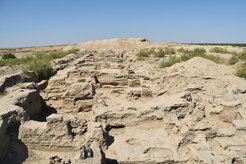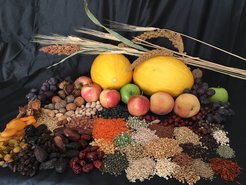FEDD: Fruits of Eurasia: Domestication and Dispersal
Many of the fruits, nuts, and grains on your dinner table once spread across the ancient world along the legendary trade routes that we colloquially refer to as the Silk Road. By studying the plants of the ancient Silk Road, we are studying the history of our food – the greatest artifacts of the ancient Silk Road are in your kitchen.
The FEDD team is an ERC-funded project, which comprises students, postdocs, and more senior scholars, all of whom are interested in understanding how the food we eat today came to be what it is. The FEDD team is closely connected to the Paleoecology Group, the FEDD group, and the DAE group.

One of the most heavily disputed topics linking the biological and social sciences is the domestication of plants and animals; however, much of this discourse has centered around a select handful of organisms. Robert Spengler’s project, “Fruits of Eurasia: Domestication and Dispersal,” steps beyond the heavy focus on cereal crops in domestication studies and looks more closely at long-generation perennials, notably fruit and nut trees. Archaeobotanical and genetic studies illustrate that these plants followed a very different pathway towards domestication, and their early cultivation represents new concepts of land tenure and farming knowledge.
The FEDD team seeks to identify the origins of some of the most familiar fruits in your kitchen and to better understand the processes of evolutionary change that resulted from human interaction with these plants. Many of these tree crops originated in the mountains of Central Asia and are tied into the ancient Silk Road trade routes. Therefore, the FEDD team will explore the mountain foothills of Inner Asia, sampling archaeological sites dating from the late Pleistocene to the Mongol conquests. We use a multidisciplinary approach to identify the ancient cultivation and eventual domestication of these.
Ultimately the FEDD project has two goals: 1) to piece together the processes of culinary and agricultural development that led to the formation of cuisines across Europe and Asia. In this sense, understanding when and how certain plants moved is crucial for understanding modern agriculture, the conservation of endangered progenitors, and the formation of cultural identities. And, 2) the project is testing models for evolution in our tree crops, hypothetically building on the idea that seed dispersal along the Silk Road directly led to the large-fruiting hybrids that we see in our grocery stores today.

The Silk Road is a hard concept for archaeologists, historians, and a range of scholars to wrap their heads around. It was never a clear road and has no set direction. During prehistoric periods, it is best thought of as a corridor of diffusion, where people gradually spread ideas across the mountain foothills. During historic periods, it is best visualized as a process of increasing exchange, with ever more stable market centers and distant sources of goods. In this way, by two millennia ago, this system of exchange had formed into the largest commerce network of the ancient world; it linked the disparate ends of the vast Eurasian supercontinent and in doing so, connected the imperial centers of East and southwest Asia.
Organized trade, including military outposts and government taxation, along the Silk Road dates back to the Han dynasty in the second century BCE. However, the exchange of goods, ideas, cultural practices, and genes through the vast expanses of desert and mountains comprising this region dates back to at least the third millennium BCE. This flow of cultural traits through Central Asia during the past four and a half millennia was a major driving force in the development of cultures across the Old World and shaped cuisines around the globe.
With the increased application of modern scientific archaeology, specifically archaeobotanical methods, in Central Asia over the past decade, the importance of farming to past peoples of eastern Central Asia is becoming clearer. In addition, the spread of specific crops and crop varieties through the mountain valleys of Central Asia directly altered farming systems across Europe and Asia, introducing crops, such as millet, to Europe and wheat to China. Archaeobotanically tracing the path that plants followed on their long journey across Central Asia, helps us understand how these foods ultimately reached your dinner plates today.

The FEDD team is tracing out the path of many familiar crops, particularly arboreal crops, as they spread across the Old World. A few examples of the studies that this project team is working on include: how and when apples spread out of Central Asia toward China and Europe; when peaches and apricots spread across the Old World; and when and from where melons spread. In order to understand these dissemination processes, Dr. Spengler is teaming up with many of the most exciting archaeological excavations currently underway across Central Asia. These projects span geographically from Mongolia to Pakistan and temporally from the late Pleistocene to the Mongol conquests. The mingling of textual evidence with a growing archaeobotanical dataset is allowing the team to explore how the Silk Road shaped the way we eat.
Follow up with ongoing research and current publications at: https://robertnspengler.com/
Related Publications
Spengler, R. N., III, Roberts, P., Boivin, N., & Petraglia, M. In Prep. Bearing Fruit: Miocene apes and apple evolution. Evolutionary Anthropology.
Spengler, R. N., III. In Review. Anthropogenic Seed Dispersal: Rethinking the origins of plant domestication. Trends in Plant Science.
Spengler, R. N., III, A. Ventresca Miller, T. Schmaus, G. Motuzaite-Matuzeviciute, B. K. Miller, S. Wilkin, W. Taylor, Y. Li, A. Harude, P. Roberts, & N. Boivin. In Press. An imagined past? Nomadic narratives in Central Eurasian Archaeology. Current Anthropology.
Spengler, R. N., III. 2019a. Fruits from the Sands: The Silk Road origins of the food we eat. Berkeley: University of California Press.
Spengler, R. N., III. 2019b. Origins of the Apple: The Role of Megafaunal Mutualism in the Domestication of Malus and Rosaceous Trees. Frontiers in Plant Science. 10(617):1-18.
Spengler, R. N., III, A. Ventresca Miller, T. Schmaus, G. Motuzaite-Matuzeviciute, B. K. Miller, S. Wilkin, W. Taylor, Y. Li, A. Harude, P. Roberts, N. Boivin. In press. An imagined past? Nomadic narratives in Central Eurasian Archaeology. Current Anthropology.
Spengler, R. N., III, & Mueller, N. 2019 Grazing Animals Drove Domestication of Grain Crops. Nature Plants. 5: 656–662.
Spengler, R. N. III., Miller, N. F., Neef, R., Tourtellotte, P. A., & Chang, C. 2017. Linking agriculture and exchange to social developments of the Central Asian Iron Age. Journal of Anthropological Archaeology 48: 295–308.
Spengler, R. N., III., de Nigris, I., Cerasetti, B., Carra, M., & Rouse, L. M. 2016a. The breadth of dietary economy in Bronze Age Central Asia: Case study from Adji Kui 1 in the Murghab region of Turkmenistan. Journal of Archaeological Science: Reports
Spengler, R. N., III., Tarasov, P. E., & Wagner, M. 2016b. Introduction to the Special Issue: Introduction and intensification of agriculture in Central Eurasia and adjacent regions. Holocene 26(10): 1523–1526.


